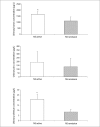Trace elements in children suffering from idiopathic nephrotic syndrome
- PMID: 25610323
- PMCID: PMC4299852
- DOI: 10.5152/eajm.2014.36
Trace elements in children suffering from idiopathic nephrotic syndrome
Abstract
Objective: Trace elements play a significant role in several metabolic processes and often circulate in the blood binding to protein. The purpose of this study was to determine the status of selenium, zinc, and boron in idiopathic nephrotic syndrome patients in active and remission phases.
Materials and methods: Fourteen patients and fourteen healthy age-matched controls were included in the study. The selenium, zinc and boron level in plasma and urine were measured by the inductively coupled plasma mass spectrometry.
Results: The plasma levels of zinc and selenium were significantly lower in both active and remission patients (for all p=0.0001). The plasma boron level was significantly lower only in patients in active phase (p=0.0002 vs control). The concentrations of urinary boron and selenium were significantly higher during active phase compared with remission (p=0.0003 and 0.0001, respectively).
Conclusion: Supplementation with zinc, selenium and boron may be justified in patients suffering with this disease.
Amaç: Eser elementler birçok metabolik süreçte yer alır ve sıklıkla proteine bağlanarak dolaşırlar. Bu çalışmada nefrotik sendromlu hastaların aktivasyon ve remisyon dönemlerinde selenyum, çinko ve bor durumlarının araştırılması amaçlanmıştır.
Gereç ve yöntem: Ondört hasta ve 14 sağlıklı, benzer yaşta kontrol grubu çalışmaya alındı. Plazma ve idrarda selenyum, çinko ve bor düzeyleri indükleyici çiftleşmiş plazma kitle spektrometri yöntemi ile ölçüldü.
Bulgular: Plazma çinko ve selenyum düzeyleri hem aktivasyon hem de remisyon döneminde anlamlı olarak düşük bulundu (hepsi için p=0,0001). Plazma bor düzeyi sadece aktivasyon döneminde anlamlı olarak düşüktü (p=0,0002, kontrol ile karşılaştırıldığında). İdrar bor ve selenyum düzeyleri aktivasyon döneminde remisyon dönemine kıyasla anlamlı olarak yüksekti (p=0,0003 ve 0,0001, sırasıyla).
Sonuç: Nefrotik sendromlu hastaların çinko, selenyum ve bor açısından desteklenmesi gerekebilir.
Keywords: Boron; children; nephrotic syndrome; selenium; zinc.
Figures


Similar articles
-
Antioxidant status of children with idiopathic nephrotic syndrome.Pediatr Nephrol. 2011 Feb;26(2):251-6. doi: 10.1007/s00467-010-1696-6. Epub 2010 Nov 21. Pediatr Nephrol. 2011. PMID: 21104098
-
Trace elements in hemodialysis and continuous ambulatory peritoneal dialysis patients.Blood Purif. 1998;16(5):253-60. doi: 10.1159/000014342. Blood Purif. 1998. PMID: 9917533
-
Influence of an Acute Exercise Until Exhaustion on Serum and Urinary Concentrations of Molybdenum, Selenium, and Zinc in Athletes.Biol Trace Elem Res. 2018 Dec;186(2):361-369. doi: 10.1007/s12011-018-1327-9. Epub 2018 Apr 5. Biol Trace Elem Res. 2018. PMID: 29623649
-
The role of copper, molybdenum, selenium, and zinc in nutrition and health.Clin Lab Med. 1998 Dec;18(4):673-85. Clin Lab Med. 1998. PMID: 9891606 Review.
-
Hair toxic and essential trace elements in children with autism spectrum disorder.Metab Brain Dis. 2017 Feb;32(1):195-202. doi: 10.1007/s11011-016-9899-6. Epub 2016 Aug 31. Metab Brain Dis. 2017. PMID: 27581303
Cited by
-
Mycophenolate Mofetil in the Treatment of Steroid-Dependent or Frequently Relapsing Nephrotic Syndrome in Children: A Meta-Analysis.Front Pediatr. 2021 Jun 15;9:671434. doi: 10.3389/fped.2021.671434. eCollection 2021. Front Pediatr. 2021. PMID: 34211944 Free PMC article.
References
-
- Stein AJ. Global impacts of human mineral malnutrition. Plant Soil. 2009;335:133–54. http://dx.doi.org/10.1007/s11104-009-0228-2. - DOI
-
- Jeejeebhoy K. Zinc: an essential trace element for parenteral nutrition. Gastroenterology. 2009;137:7–12. http://dx.doi.org/10.1053/j.gastro.2009.08.014. - DOI - PubMed
-
- Tanguy S, Grauzam S, de Leiris J, et al. Impact of dietary selenium intake on cardiac health: experimental approaches and human studies. Mol Nutr Food Res. 2012;56:1106–21. http://dx.doi.org/10.1002/mnfr.201100766. - DOI - PubMed
-
- Nielsen FH, Meacham SL. Growing Evidence for Human Health Benefits of Boron. Journal of Evidence-Based Complementary & Alternative Medicine. 2011;16:169–80. http://dx.doi.org/10.1177/2156587211407638. - DOI
-
- Hunt CD. Dietary boron: progress in establishing essential roles in human physiology. J Trace Elem Med Biol. 2012;26:157–60. http://dx.doi.org/10.1016/j.jtemb.2012.03.014. - DOI - PubMed
LinkOut - more resources
Full Text Sources
Other Literature Sources
